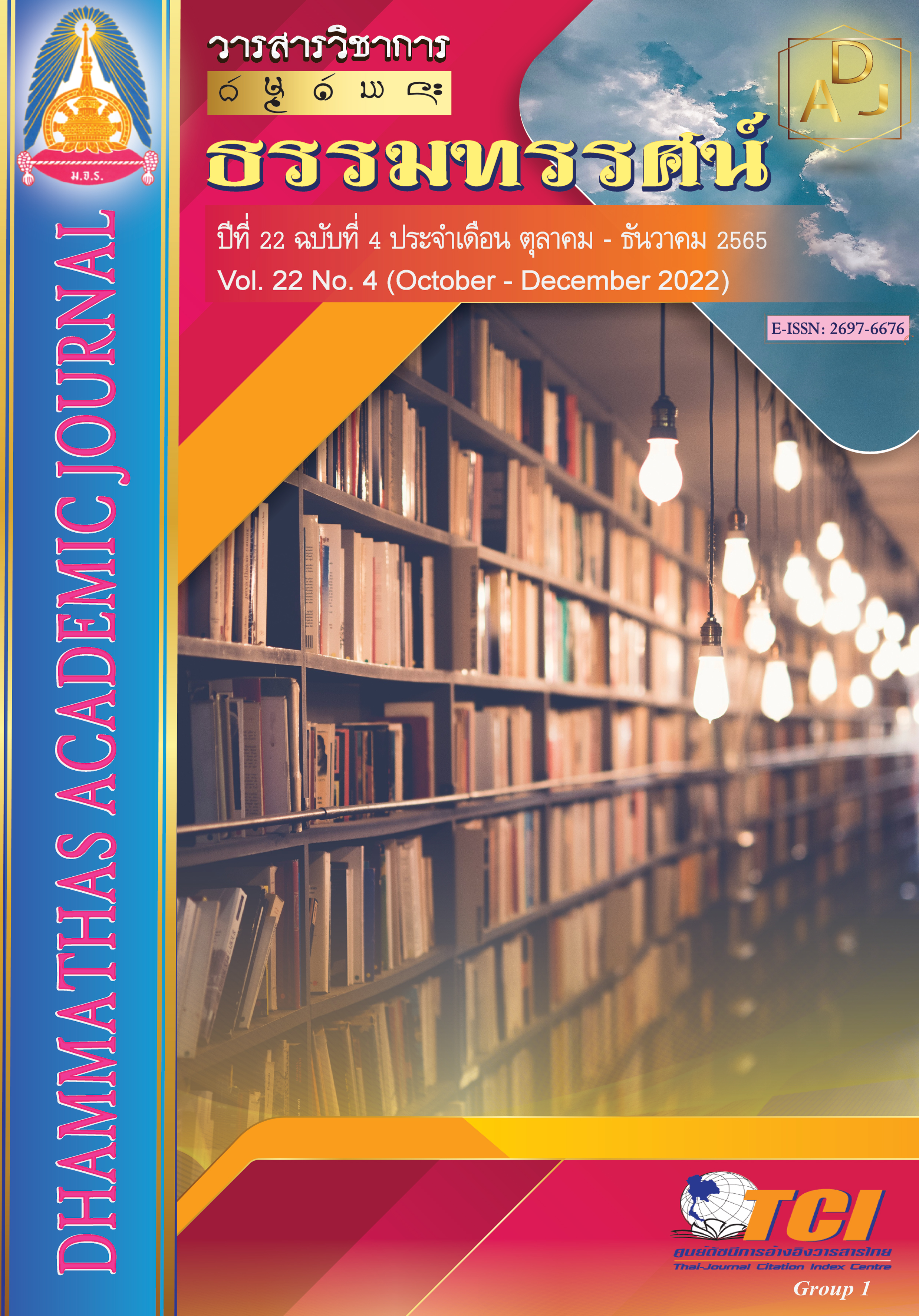The Guidelines for Promoting Morality and Ethics in the Parivāsakamma Meritorious Activity, Phen District, Udon Thani Province
Main Article Content
Abstract
The objectives of this research were: 1) to study the promotion of morality and ethics in the Parivāsakamma meritorious activity during the Buddha's time; 2) to study the promotion of morality and ethics in the Parivāsakamma meritorious activity in Phen District, Udon Thani Province, and 3) to study the guidelines for promoting morality and ethics in the Parivāsakamma meritorious activity in Phen District. This study was carried out by means of qualitative research by collecting the documents and in-depth interviews. The obtained data were interpreted by a descriptive writing.
The research results were as follows:
1. The Parivāsakamma meritorious activity of monks has existed since the Buddha's time. This activity appears in the Dhamma Vinaya and the Tipitaka in four types: 1) Appaṭicachannaparivāsa (Parivāsa for laypeople); 2) Paṭicachannaparivāsa; 3) Samodhānaparivāsa; 4) Sudadhantaparivāsa.
2. The Parivāsakamma meritorious activity of Wat Roi Phra Phutthabat Naruenat, Tao Hai Subdistrict Community, Phen District, Udon Thani Province is organized as the Cuḷasudadhantaparivāsa in nine nights and ten days due to its convenience of practice.
3. The Parivāsakamma of monks affects the Buddhist community of Tao Hai Subdistrict, Phen district, Udon Thani province. In addition to the practice of monks and those who are interested, it encouraged people in the community to perform giving in order to build friendship and relationships among the people in the community, to keep the precepts and to keep the body and speech, do not cause trouble for the people in the community. People also cultivated compassion, and this made them become good people or complete human beings with good morals and ethics because of the correct learning. This created a strong community, and the community members have knowledge and understanding in the same direction. They were able to practice correctly according to the doctrine, resulting in many aspects such as oneself, family, society, Buddhism, culture, customs, politics, and governance.
Article Details

This work is licensed under a Creative Commons Attribution-NonCommercial-NoDerivatives 4.0 International License.
เพื่อให้เป็นไปตามกฎหมายลิขสิทธิ์ ผู้นิพนธ์ทุกท่านต้องลงลายมือชื่อในแบบฟอร์มใบมอบลิขสิทธิ์บทความ ให้แก่วารสารฯ พร้อมกับบทความต้นฉบับที่ได้แก้ไขครั้งสุดท้าย นอกจากนี้ ผู้นิพนธ์ทุกท่านต้องยืนยันว่าบทความ ต้นฉบับที่ส่งมาตีพิมพ์นั้น ได้ส่งมาตีพิมพ์เฉพาะในวารสาร วิชาการธรรม ทรรศน์ เพียงแห่งเดียวเท่านั้น หากมีการใช้ ภาพหรือตารางของผู้นิพนธ์อื่นที่ปรากฏในสิ่งตีพิมพ์อื่นมาแล้ว ผู้นิพนธ์ต้องขออนุญาตเจ้าของลิขสิทธิ์ก่อน พร้อมทั้ง แสดงหนังสือที่ได้รับการยินยอมต่อบรรณาธิการ ก่อนที่บทความจะได้รับการตีพิมพ์References
โชติ ศรีสุวรรณ. (2552). ประเพณีสิบสองเดือน. (พิมพ์ครั้งที่ 2). กรุงเทพฯ: สถาพรบุ๊คส์.
นันทวัน สาวนายน. (2550). บุญเข้ากรรม. ในบรรณานุกรมขนบประเพณีไทย หมวดประเพณีราษฎร์. กรุงเทพฯ: สำนักวรรณกรรมและประวัติศาสตร์.
ประพิศ โบราณมูล. (2554). บทความวิจัยการปฏิบัติตนตามหลักธรรม บุญกิริยาวัตถุ 3 ของข้าราชการครูในโรงเรียนเทศบาล สังกัดเทศบาลเมืองร้อยเอ็ด จังหวัดร้อยเอ็ด. วารสารสถาบันญาณสังวรมหาวิทยาลัยมหามกุฏราชวิทยาลัย, 2(1), 53-62.
พระมหาวิจิตร ธีรญาโณ. (2556). การศึกษาการเข้าอยู่ปริวาสกรรมของพระสงฆ์ไทยในปัจจุบัน. (วิทยานิพนธ์พุทธศาสตรมหาบัณฑิต). พระนครศรีอยุธยา: มหาวิทยาลัยมหาจุฬาลงกรณราชวิทยาลัย.
พระวิจัย อิทฺธิโก (ชัยเจริญวรรณ). (2561). การพัฒนาคุณภาพชีวิตเชิงพุทธบูรณาการของกลุ่มชาติพันธุ์อาข่าบนดอยแม่ฟ้าหลวง. (วิทยานิพนธ์พุทธศาสตรดุษฎีบัณฑิต). พระนครศรีอยุธยา: มหาวิทยาลัยมหาจุฬาลงกรณราชวิทยาลัย.
มหาจุฬาลงกรณราชวิทยาลัย. (2539). พระไตรปิฎกภาษาไทย ฉบับมหาจุฬาลงกรณราชวิทยาลัย. กรุงเทพฯ: มหาจุฬาลงกรณราชวิทยาลัย.
สมเด็จพระญาณสังวร, สมเด็จพระสังฆราช สกลมหาสังฆปริณายก. (2553). วิธีสร้างบุญบารมี. (พิมพ์ครั้งที่ 28). กรุงเทพฯ: พิมพ์สวย.
อุดม บัวศรี. (2546). วัฒนธรรมอีสาน. ขอนแก่น: คลังนานาวิทยา.
อุทัย บุญเย็น. (2554). พระไตรปิฎกฉบับผู้เริ่มศึกษาพระวินัยปิฎก เล่ม 4. กรุงเทพฯ: โพธิ์เนตร.

